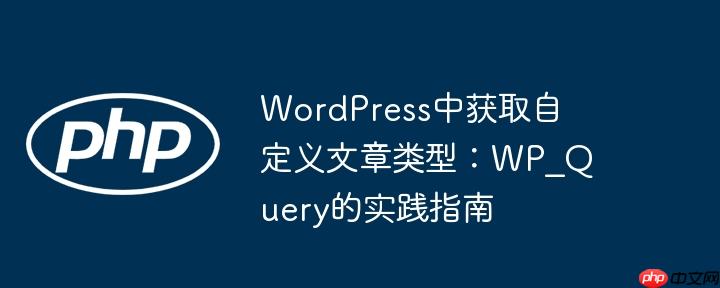
理解WordPress查询机制与自定义文章类型
WordPress是一个高度可定制的内容管理系统,其核心在于WP_Query类,它负责从数据库中检索各种类型的内容,包括文章(posts)、页面(pages)、附件(attachments)以及用户自定义的文章类型(Custom Post Types, CPTs)。在许多插件和主题中,默认的查询行为通常是获取标准文章类型(post)。然而,当需要展示特定自定义文章类型的内容时,例如一个名为“properties”的自定义房产信息,就需要修改查询参数以明确指定目标文章类型。
WP_Query核心:post_type参数
WP_Query类通过一系列参数来定义查询的范围和条件。其中,post_type参数是指定要查询的文章类型的关键。它的值可以是单个文章类型的名称字符串,也可以是包含多个文章类型名称的数组。
例如,要查询名为properties的自定义文章类型,post_type参数应设置为: 'post_type' => 'properties'
如果需要同时查询标准文章和自定义文章类型properties,可以这样设置: 'post_type' => array('post', 'properties')
构建自定义文章类型查询
下面是一个典型的WP_Query结构,用于获取特定自定义文章类型的内容。此示例将获取名为properties的自定义文章类型,并进行分页和排序。
'properties', // 指定自定义文章类型为 'properties'
'post_status' => 'publish', // 只获取已发布的文章
'posts_per_page' => 10, // 每页显示10篇文章
'orderby' => 'date', // 按发布日期排序
'order' => 'DESC', // 降序排列(最新发布在前)
// 更多参数可根据需求添加,例如:
// 'category_name' => 'featured', // 按分类别名查询
// 'meta_key' => 'price', // 按自定义字段键排序
// 'paged' => get_query_var('paged') ? get_query_var('paged') : 1, // 分页参数
);
// 实例化 WP_Query
$custom_query = new WP_Query( $args );
// 循环遍历查询结果
if ( $custom_query->have_posts() ) {
echo '- ';
while ( $custom_query->have_posts() ) {
$custom_query->the_post(); // 设置当前文章数据
?>
-
- $args 数组:包含了所有查询条件。post_type被设置为'properties',确保只获取该类型的文章。
- new WP_Query( $args ):创建WP_Query的一个新实例,并传入定义的参数。
- $custom_query->have_posts():检查是否有文章符合查询条件。
- $custom_query->the_post():在循环中,为每次迭代设置全局$post变量,以便可以使用the_permalink(), the_title(), the_excerpt()等模板标签。
- wp_reset_postdata():至关重要! 在完成自定义查询循环后,必须调用此函数,以恢复全局$post变量到主查询的状态。这可以防止自定义查询对页面上的其他WordPress查询(如侧边栏小工具、主循环等)造成意外影响。
-
查找WP_Query实例化点:
- 如果您正在修改一个主题,通常可以在index.php、archive.php、category.php或自定义模板文件中找到WP_Query的实例化。
- 如果您正在处理一个插件,您需要查看插件的源代码,找到它如何构建其查询的。插件通常会提供过滤器(filters)或动作(actions)钩子,允许您在不直接修改插件核心文件的情况下修改查询参数。
-
修改$args参数: 一旦找到WP_Query的实例化点,您就可以修改传递给WP_Query构造函数的$args数组,将'post_type' => 'properties'添加到其中。
示例场景(假设在某个调用loop-post.php的父文件中):
'properties', // 将默认的 'post' 替换为 'properties' 'post_status' => 'publish', 'posts_per_page' => 8, 'orderby' => 'title', 'order' => 'ASC', ); $the_custom_query = new WP_Query( $query_args ); // 然后将这个自定义查询对象传递给模板 $template_args = array( 'template_args' => array( 'the_query' => $the_custom_query, 'title' => '我的房产列表', ), ); uwp_get_template('loop-post.php', $template_args); // 重要的是在主查询结束后恢复数据 wp_reset_postdata(); ?>通过这种方式,loop-post.php将接收到一个已经配置好查询自定义文章类型properties的WP_Query对象。
-
避免直接修改插件文件:
- 子主题(Child Theme): 如果您正在修改主题模板,建议使用子主题来覆盖父主题的模板文件。这样,当父主题更新时,您的修改不会丢失。
- 插件过滤器(Plugin Filters): 许多插件会提供过滤器,允许您修改其内部的WP_Query参数。这是最推荐的方法,因为它不会影响插件的未来更新。您需要查阅插件文档以了解可用的过滤器。
- 自定义模板: 如果插件允许您指定自定义模板文件,您可以复制并修改loop-post.php到您的子主题或自定义位置,并在其中直接构建WP_Query。
- 自定义文章类型注册: 在尝试查询自定义文章类型之前,请确保该类型已通过register_post_type()函数正确注册。
- 性能考量: 当处理大量文章时,不当的WP_Query参数可能会导致性能问题。确保您的查询尽可能精确,并考虑使用缓存插件来优化性能。
- 调试: 如果查询结果不符合预期,可以使用var_dump($custom_query->request);来查看生成的SQL查询语句,或使用$custom_query->get_posts();来获取文章对象数组,以便进行调试。
- wp_reset_postdata()的重要性: 再次强调,自定义查询后务必调用wp_reset_postdata(),以避免全局$post对象被污染,影响页面其他部分的正常显示。
暂无相关房产信息。
'; } // 恢复原始文章数据(非常重要,以避免影响后续查询) wp_reset_postdata(); ?>代码解释:
集成到现有模板或插件逻辑
根据您提供的loop-post.php和posts-post.php文件,可以观察到$the_query对象是通过$args['template_args']['the_query']传入loop-post.php的。这意味着实际的WP_Query实例化和参数定义发生在调用uwp_get_template('posts-post.php', $args)的地方。
要将默认文章查询替换为自定义文章类型查询,您需要找到生成并传递$the_query对象的原始代码位置。
一般集成策略:
注意事项
总结
在WordPress中,通过WP_Query类及其post_type参数,您可以精确控制要获取和显示的内容类型。无论是直接在模板文件中构建查询,还是通过修改插件或主题的查询参数,理解WP_Query的工作原理都是实现高度定制化内容展示的关键。遵循最佳实践,如使用子主题和插件过滤器,可以确保您的网站在功能和可维护性方面都表现出色。






























